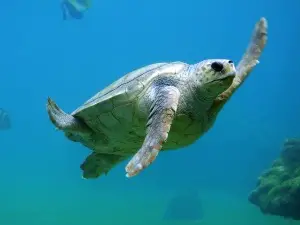
How your pet’s shell looks has a lot to do with the animal’s age, species, and the environment around it. If the bottom of your turtle’s shell is pink then you’ll likely start to get worried
This article looks into why the bottom of your turtle’s shell is pink.
Table of Contents
Why is the bottom of my turtle’s shell pink?
A color change anywhere on your turtle is a sign that there’s something going on with the animal,
Here is why the bottom of your turtle’s shell is pink:
Normal growth:
If the bottom of your pet’s shell is pink and the reptile is young, then the area may be pink because your pet is growing, and growing fast.
When turtles grow, their skin thins out because it can’t keep up with the speed at which the body is growing.
As a result of this skin thinning, blood vessels under the animal’s skin will start to become visible and this will make the skin look pink
What to do:
You don’t have to worry at all if this is happening with your pet, this is normal and isn’t a sign that your pet is sick.
As long as the little turtle isn’t showing signs of distress, signs of illness, and its behavior isn’t changing then your pet will be fine. The skin will catch up with the animal’s growth over time.
As time passes the skin will become thicker and yellow, or it will turn to what is normal for that particular species of turtle, and you won’t be able to see the blood vessels underneath.
Septicemia:
Another reason why your turtle may have a pink plastron (the bottom of the shell) may be that the animal has a condition called septicemia.
Septicemia is a potentially life-threatening blood infection that is actually quite common in turtles.
It develops in your pet when harmful bacteria, fungi, or other toxins enter the animal’s body, flow through the bloodstream, and cause a body-wide infection.
Your pet may have developed this condition after it suffered a shell injury, a skin wound, a respiratory infection, or if it suffered an underlying health condition.
The bacteria, fungi, or other toxins that cause this condition triggers the animal’s body to increase blood flow to the skin by causing the blood vessels to widen. This makes the skin look pink
In addition to the pink plastron, other signs of this condition in your pet include weakness, a loss of appetite, abnormal behavior, convulsions, breathing difficulties, and weakness.
What to do:
Taking your pet to the vet, or better yet to a herp vet, is recommended, you’d need to do this as soon as you can.
Your vet will prescribe antibiotics to get rid of the infection in your pet. The animal may also need to be hospitalized and given intravenous fluids as a part of its treatment.
If you can’t immediately get your pet to the vet then you can isolate it as a way of keeping its condition from spreading to your other turtles.
Isolating the animal will also keep it from having to exert too much energy to compete for food and water,
Ensure your pet’s diet is balanced and clean throughout
If you enjoyed this article then you may also be interested in other turtle/tortoise related articles. Here are some articles that you may be interested in: Why Is My Tortoise Making Chirping Noises?, Why Is My Tortoise Squeaking And Not Eating?, Sulcata Tortoise Squeaking, Sulcata Tortoise Squeaking While Sleeping, Can Pyramiding On A Tortoise Be Reversed?, Why Is My Turtles Shell Bending Up?, My Red-Eared Slider Keeps Opening His Mouth

